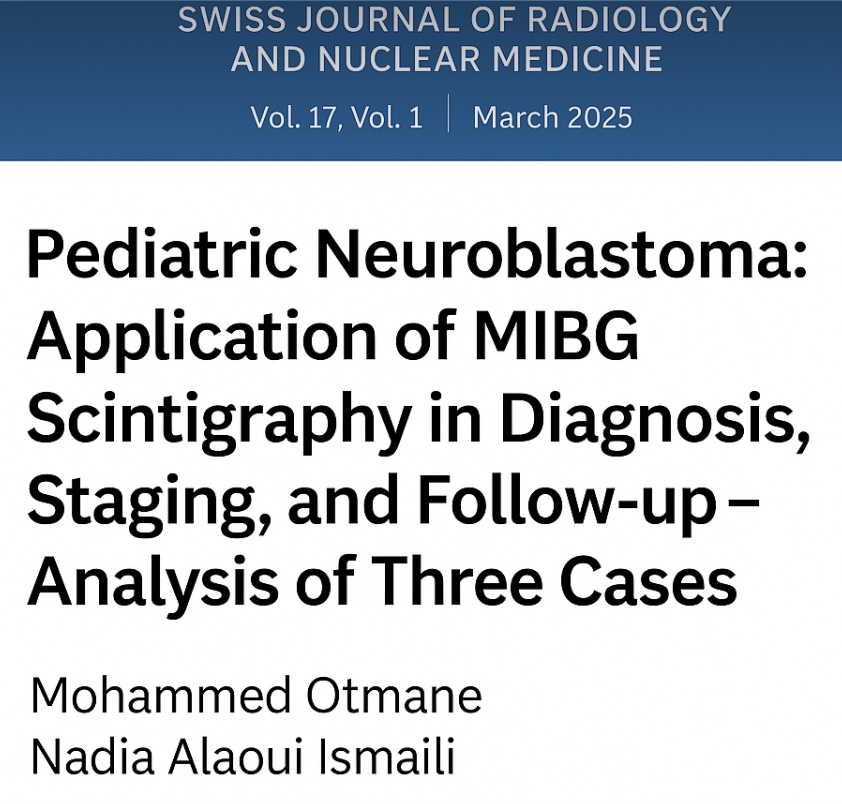The Pediatric Neuroblastoma: Application of MIBG Scintigraphy in Diagnosis, Staging, and Follow-up – Analysis of Three Cases
DOI:
https://doi.org/10.59667/sjoranm.v17i1.14Keywords:
MIBG scintigraphy, Tumor staging, Metastasis detection, pediatric oncology, NeuroblastomaAbstract
Introduction: Neuroblastoma is the most common extracranial solid tumor in children, accounting for 8-10% of all pediatric cancers. Accurate diagnosis and management rely on imaging modalities and biological markers such as elevated urinary catecholamines. Among the various imaging techniques, Metaiodobenzylguanidine (MIBG) scintigraphy, often combined with SPECT/CT, provides high specificity for neuroblastoma cells. It is crucial for determining tumor extent, identifying metastatic disease, and monitoring therapeutic response.
Materials and Methods: This study presents three clinical cases illustrating the role of MIBG scintigraphy in the diagnosis, staging, and follow-up of pediatric neuroblastoma. The three patients underwent Iodine-131 labeled MIBG scintigraphy, with planar imaging, and in two cases, additional SPECT/CT imaging.
Results :
- Case 1: A 3-year-old child with a right adrenal mass and diffuse bone marrow metastases, classified as stage IV neuroblastoma.
- Case 2: An 11-year-old girl with recurrent retroperitoneal neuroblastoma identified during follow-up MIBG scintigraphy.
- Case 3: An 11-year-old girl with no evidence of disease progression, confirmed by MIBG scintigraphy, indicating complete remission.
Conclusion: MIBG scintigraphy is an invaluable tool in the management of neuroblastoma, offering precise tumor localization, accurate staging, and effective monitoring of treatment response. Its integration into clinical practice helps guide therapeutic decisions and improves patient outcomes.
References
1. Park JR, Eggert A, Caron H. Neuroblastoma: biology, prognosis, and treatment. Pediatric Clinics of North America. 2008;55(1):97-120.
2. Maris JM. Recent advances in neuroblastoma. New England Journal of Medicine. 2010;362(23):2202-2211.
3. Smith MA, Seibel NL, Altekruse SF, et al. Outcomes for children and adolescents with cancer: challenges for the twenty-first century. Journal of Clinical Oncology. 2010;28(15):2625-2634.
4. Brodeur GM. Spontaneous regression of neuroblastoma. Cell and Tissue Research. 2018;372(2):277-286.
5. Kushner BH. Neuroblastoma: a disease requiring a multitude of imaging studies. Journal of Nuclear Medicine. 2004;45(7):1172-1188.
6. Shulkin BL, Thompson NW, Shapiro B, et al. Pheochromocytomas and neuroblastomas: diagnostic imaging with 131-I MIBG. Radiology. 1986;161(3):491-495.
7. Matthay KK, Shulkin B, Ladenstein R, et al. Criteria for evaluating disease extent by 123I-MIBG scans in neuroblastoma: a report from the International Neuroblastoma Risk Group (INRG) project. Pediatric Blood & Cancer. 2010;56(1):50-56.
8. Taggart DR, Han MM, Quach A, et al. Comparison of 123I-MIBG and 18F-FDG PET scans in patients with relapsed neuroblastoma. Journal of Nuclear Medicine. 2009;50(8):1237-1243.
9. Sisson JC, Frager MS, Valk TW, et al. Scintigraphic localization of pheochromocytoma. New England Journal of Medicine. 1981;305(1):12-17.
10. Brisse HJ, McHugh K, Owens CM, et al. Guidelines for imaging and staging of neuroblastic tumors: consensus report from the International Neuroblastoma Risk Group Project. Radiology. 2011;261(1):243-257.
11. Gaze MN, Chang YC, Flux GD, et al. Feasibility of dosimetry-based high-dose 131I-MIBG therapy for neuroblastoma. Nuclear Medicine Communications. 2005;26(8):725-732.
12. Sharp SE, Gelfand MJ, Shulkin BL. Pediatrics: diagnosis of neuroblastoma with 123I-MIBG scintigraphy. Radiographics. 2011;31(6):1637-1646.
13. Kembhavi SA, Shah S, Rangarajan V, et al. Imaging in neuroblastoma: an update. Indian Journal of Radiology and Imaging. 2015;25(2):129-136.
14. Sgouros G, Kolbert KS, Sheikh A, et al. Patient-specific dosimetry for 131I-MIBG therapy of neuroblastoma. Medical Physics. 2001;28(11):2155-2165.
15. Buckley SE, Gaze MN. The role of MIBG therapy in the treatment of neuroblastoma. Advances in Therapy. 2006;23(5):728-736.
16. Shapiro B, Sisson JC, Shulkin BL. The current status of metaiodobenzylguanidine and analogues in the diagnosis and treatment of neuroblastoma. Quarterly Journal of Nuclear Medicine. 1995;39(2):114-121.
17. Monsieurs MA, Brans B, et al. Dosimetric considerations in 131I-MIBG therapy for neuroblastoma. European Journal of Nuclear Medicine and Molecular Imaging. 2002;29(1):102-111.
18. Kushner BH, Yeh SJ, Kramer K, et al. Impact of surveillance studies on prognostication and treatment of high-risk neuroblastoma. Journal of Clinical Oncology. 2003;21(17):3404-3410.
19. Gaze MN. The role of thyroid blockade in 131I-MIBG therapy. Nuclear Medicine Communications. 2008;29(2):109-112.
20. Sisson JC, Wieland DM. Radiopharmaceuticals for the diagnosis and treatment of pheochromocytoma. Nuclear Medicine and Biology. 1986;13(3):237-242.
21. Kushner BH, LaQuaglia MP, Modak S, et al. Neuroblastoma in children: clinical presentation and diagnostic considerations. Seminars in Pediatric Surgery. 2004;13(3):188-194.
22. McEwan AJ, Shapiro B, Sisson JC, et al. Gastrointestinal activity in MIBG scintigraphy: challenges and solutions. Journal of Nuclear Medicine. 1995;36(5):857-863.
23. Ladenstein R, Philip T, Lasset C, et al. Prognostic factors in metastatic neuroblastoma: correlation of MIBG imaging with other diagnostic modalities. European Journal of Cancer. 2003;39(5):635-641.
24. Villablanca JG, Matthay KK, et al. The role of imaging in assessing therapy response and disease progression in neuroblastoma. Journal of Clinical Oncology. 2009;27(7):1020-1025.

Downloads
Published
Issue
Section
License
Copyright (c) 2025 Mohammed Otmane, Nadia Alaoui Ismaili

This work is licensed under a Creative Commons Attribution 4.0 International License.
This license requires that reusers give credit to the creator. It allows reusers to distribute, remix, adapt, and build upon the material in any medium or format, even for commercial purposes.








